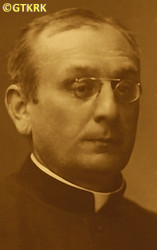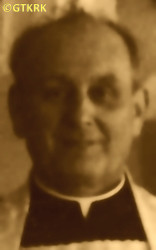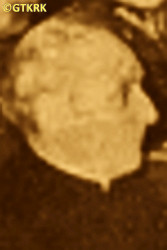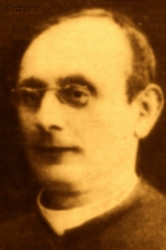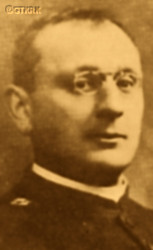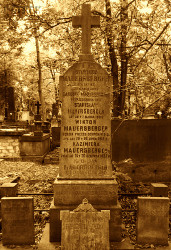Roman Catholic
St Sigismund parish
05-507 Słomczyn
85 Wiślana Str.
Konstancin deanery
Warsaw archdiocese, Poland
full list:
displayClick to display full list

searchClick to search full list by categories
wyświetlKliknij by wyświetlić pełną listę po polsku

szukajKliknij by przeszukać listę wg kategorii po polsku

Martyrology of the clergy — Poland
XX century (1914 – 1989)
personal data
surname
MAUERSBERGER
forename(s)
John Paul (pl. Jan Paweł)
function
diocesan priest
creed
Latin (Roman Catholic) Church RCmore on
en.wikipedia.org
[access: 2014.09.21]
diocese / province
Warsaw archdiocesemore on
en.wikipedia.org
[access: 2013.05.19]
RC Military Ordinariate of Polandmore on
en.wikipedia.org
[access: 2014.12.20]
academic distinctions
Doctor of Sacred Theology
Doctor of Canon Law
honorary titles
Rochettum et Mantolettum canonmore on
en.wikipedia.org
[access: 2014.11.14]
Papal chamberlainmore on
en.wikipedia.org
[access: 2014.11.22]
Grand Cross „Polonia Restituta”more on
en.wikipedia.org
[access: 2019.04.16]
Commander's Cross with Star „Polonia Restituta”more on
en.wikipedia.org
[access: 2019.04.16]
Commander's Cross „Polonia Restituta”more on
en.wikipedia.org
[access: 2019.04.16]
„Cross of Independence”more on
en.wikipedia.org
[access: 2019.02.02]
Knight's Cross „Polonia Restituta”more on
en.wikipedia.org
[access: 2019.04.16]
Gold „Cross of Merit”more on
en.wikipedia.org
[access: 2019.04.16]
Honorary Badge of the „Scout Eagle”more on
pl.wikipedia.org
[access: 2024.12.13]
date and place
of death
12.08.1942

Konstancintoday: part of Konstancin‐Jeziorna, Konstancin‐Jeziorna gm., Piaseczno pov., Masovia voiv., Poland
more on
en.wikipedia.org
[access: 2022.01.28]
details of death
After returning from his studies in Rome to Russian controlled Poland in 1903, due to the lack of Russian occupiers' consent to take up the position of a catechist, a teacher at clandestine classes — till 1905, when obtained permission to teach.
Still however — till 1915, when the Russians, after the defeat in the Battle of Gorlice in 05.1919, during World War I, were forced out of Warsaw by the Central Powers and the Germans — in the diocesan structures was recorded as a priest „without assignment”. This resulted from the fact that the Russians did not allow Catholic priests to deepen their education outside the Russian Empire, and the only higher education institution where this could have been achieved was the Roman Catholic Theological Academy in Sankt Petersburg. Himself however obtained his education in Rome, without Russian consent.
Till c. 1910, an activist of the Union of Polish Youth „Zet”, a clandestine organization of Polish academic youth in Warsaw, then the capital of the Russian–controlled Rus. Царство Польское (Eng. Polish Kingdom), and then an activist of the Independence Youth Organization „Zarzewie” (Eng. „Embers”), leading, among other things, a boycott of Russian education in Rus. Царство Польское.
From 1911, a member of the emerging secret scouting movement in Warsaw. The oldest troop was founded on 10.10.1910 at the Witold Wróblewski Gymnasium (later Thaddeus Czapski Gymnasium). At the turn of 1910/1911, a troop was founded at the Marian Rychłowski Gymnasium (later Thaddeus Reytan Gymnasium), and in 10.1911 at the Stanislav Staszic RealSchule. The decision to create Scouting in partitioned Poland was made at a meeting on 26.02.1911 in Lviv, in the Austrian partition, where Scouting activities were legal. In the Russian partition, in Warsaw, under clandestine conditions, the illegal Supreme Scout Command was established at the end of 1911.
Just before the outbreak of World War I, in 07.1914 was the chaplain of the first instructor course in Skole, then still in the Austro–Hungarian Empire.
After the end of World War I and the rebirth of the Polish state on 11.11.1918 — on that day in a staff wagon in Compiègne, in the headquarters of French Marshal Ferdinand Foch, an armistice was signed between the Allies and the Germans; on the same day, the Regency Council established by the Central Powers (Germany and Austro–Hungary) and operating in the so‐called Germ. Königreich Polen (Eng. Kingdom of Poland), transferred supreme authority over the army to Brigadier Joseph Piłsudski and appointed him Commander‐in‐Chief of the Polish Army, which de¬facto meant the rebirth of the Polish state — became chaplain of the 1st Engineering Regiment. The formation of the Regiment basically began on 11.11.1918, when young people from the Warsaw University of Technology began to report for service in large numbers. The regiment — its battalions — took part in almost all campaigns of the Polish–Russian War of 1919‐1921, including in the battles on the Dvina on the Lithuanian–Belarusian front, in Belarus and Volyn, during the retreat of the Polish army from the Russian offensive in 1920, during the Battle of Warsaw on c. 15.08.1920 (known as the „Miracle on the Vistula”), e.g. in the battles in vicinity of Mława and Płońsk.
In 1920, prob. during the Russian offensive and the aforementioned Battle of Warsaw, directed on behalf of the Polish Red Cross PCK, as a chaplain, the educational campaign in Warsaw hospitals.
After the German and Russian invasions of Poland in 09.1939 and start of World War II, a day before the capitulation of Warsaw (28.09.1939), co‐founded an clandestine, resistance scout organization, the continuator of the Polish Scouting Association ZHP.
Later, in 1940, during the German and Russian occupations, the organization adopted the name of „Szare Szeregi” (Eng. „Gray Ranks”) and became part of the Polish Clandestine State.
Became its chairman under the „Fr Longin” nom‐de‐guerre.
Hunted by the Germ. Geheime Staatspolizei (Eng. Secret State Police), i.e. Gestapo, went into hiding.
While in hiding perished in Konstancin.
cause of death
disease
perpetrators
Germans
sites and events
GeneralgouvernementClick to display the description, Ribbentrop‐MolotovClick to display the description, Pius XI's encyclicalsClick to display the description, Polish‐Russian war of 1919‐1921Click to display the description
date and place
of birth
04.09.1877

Warsawtoday: Warsaw city pov., Masovia voiv., Poland
more on
en.wikipedia.org
[access: 2021.10.09]
parents
MAUERSBERGER Victor
🞲 ?, ? — 🕆 ?, ?

REINHARD Mary Casimira
🞲 ?, ? — 🕆 ?, ?
baptism
07.10.1877

Warsawtoday: Warsaw city pov., Masovia voiv., Poland
more on
en.wikipedia.org
[access: 2021.10.09]
St Alexander the Martyr RC church
presbyter (holy orders)
ordination
08.12.1902

Rometoday: Rome prov., Lazio reg., Italy
more on
en.wikipedia.org
[access: 2021.12.18]
positions held
1939 – 1942
chairman — clandestine Polish Scouting Association ZHP („Grey Ranks”)
c. 1903 – c. 1939
prefect — Warsawtoday: Warsaw city pov., Masovia voiv., Poland
more on
en.wikipedia.org
[access: 2021.10.09] ⋄ school(s) — i.a. the Emilian Konopczyński's Gymnasium (from 1913 named after Emilian Konopczyński, from 1905 lectures in Polish), where came into contact with the then clandestine scouting movement (the 3rd Warsaw Scouting Team, that during the World War I adopted the name of Prince Joseph Poniatowski) and till 1927 the 6‐class school for girls (from 1916 gymnasium) of Hedwig Kowalczyk („Black Hedwig”) and Hedwig Jawurkówna („White Hedwig”); also a lecturer in the methodology of religion teaching at the Teacher Training Courses (later the State Teacher Training Courses) and from 1926 prefect at the Women's Teacher Training Seminary run by the Catholic Union of Polish Women
1934 – 1939
chancellor — Warsawtoday: Warsaw city pov., Masovia voiv., Poland
more on
en.wikipedia.org
[access: 2021.10.09] ⋄ Bishop's Curia of the Polish Military, Polish Armed Forces — also: chaplain of the Marshal Jospeh Piłsudski Cadet Corps No. 1 in Lviv, Chief Chaplain of the Reservists' Union, the War Disabled Persons' Union and honorary chaplain of the Veterans' Union of the 1863 Uprising
01.01.1934
RC military dean — Polish Armed Forces — promotion: on 27.12.1933, called up from the general conscription to active service and nominated as a dean of the Military Ordinariate, with seniority from 01.01.1934 and 1st place in the military clergy ranks of the Roman Catholic denomination, in the rank of colonel
1931 – 1939
vice‐chairman — Polish Scouting Association ZHP — also: from 1938 chairman of the Council for Religious Affairs of the ZHP
1931 – 1939
membership — Supreme Scout Council, Polish Scouting Association ZHP
chaplain — Reserve League, Polish Armed Forces
24.04.1927 – 20.12.1929
chairman — Polish Scouting Association ZHP — from 1927 in the rank of Scoutmaster of the Republic of Poland
1924 – 1925
Chaplain in Chief — Polish Scouting Association ZHP — in 1924 awarded the title of Honorary Scout of the Republic of Poland
07.04.1923 – 10.11.1923
chairman — Polish Scouting Association ZHP
03.07.1920 – 1923
vice‐chairman — Polish Scouting Association ZHP
1920 – 1929
membership — Supreme Scout Council, Polish Scouting Association ZHP — organization was established on 01‐02.11.1918 in Lublin, at a joint congress of scout organizations from the Polish lands of the three partitions of Poland
1920 – 1924
RC military pastor — Polish Armed Forces — commissioned, from c. chaplain of the Infantry Cadet School in Warsaw and the Military Aviation Inspectorate; on 30.11.1924, at his own request, transferred to the reserve officers' corps; earlier: by decree of the Chief of State of 03.05.1922, confirmed with seniority from 01.06.1919 and 5th place on the list of Roman Catholic military pastors, in the rank of lieutenant colonel; on 16.12.1921, by decree No. L. 3448 of the Commander‐in‐Chief, verified with seniority from 01.04.1920 and 5th place on the list of Roman Catholic military pastors, in the rank of lieutenant colonel; also: 1921‐1924 first chairman of the Warsaw Branch Commission of the Youth Groups of the Polish Red Cross PCK; from 23.06.1919 to 1923 member of the Main Board of the Central Union of Rural Youth ZMW
1918 – 1920
RC military chaplain — 1st Engineering Regiment, Polish Armed Forces
1916 – 1918
Commander in Chief — Chief Command, Polish Scouting Association ZHP — appointed on 01‐02.11.1916 in Warsaw, at the Unification Congress of scouting organizations, operating in the area of the German–occupied Warsaw General Governorate and Austro–Hungarian–occupied Lublin General Governorate; also an employee of the Department of Education in temporary Council of State of the future Kingdom of Poland established in 1917 by the German and Austro–Hungarian occupiers, preparing teachers for work in a Polish school
1915 – 1916
membership — (occupational General Governorates’ 1915‐1918 territory)German Imperial General Governorate of Warsaw (Germ. Kaiserlich‐deutsche Generalgouvernement Warschau) and Military General Governorate of Lublin (Germ. Militärgeneralgouvernement Lublin)
today: Poland
more on
pl.wikipedia.org
[access: 2023.11.24] ⋄ Supreme Scout Command
1914
chaplain — Skoletoday: Skole urban hrom., Stryi rai., Lviv obl., Ukraine
more on
en.wikipedia.org
[access: 2020.11.20] ⋄ first instructor course, scouting
till c. 1903
PhD student — Rometoday: Rome prov., Lazio reg., Italy
more on
en.wikipedia.org
[access: 2021.12.18] ⋄ theology and canon law — studies crowned with a Sacred Theology and Canon Law PhD Doctor’ degrees
till c. 1902
student — Rometoday: Rome prov., Lazio reg., Italy
more on
en.wikipedia.org
[access: 2021.12.18] ⋄ philosophy and theology
c. 1898 – c. 1899
student — Warsawtoday: Warsaw city pov., Masovia voiv., Poland
more on
en.wikipedia.org
[access: 2021.10.09] ⋄ philosophy and theology, Metropolitan Theological Seminary
writer and publicist — author of i.a. „Scout catechism, or what every scout should know” (under the pseudonym Fr Longin, Warsaw 1917); „Scout Catechism, or What Every Girl Scout Should Know” (under the pseudonym Fr Longin, Warsaw 1917); „Marian Fathers in the past and today” (Marian Fathers publishing, Warsaw, 1918); „A brave boy or a brave girl is a brave…” (Warsaw 1919); „Commentary on the Scout Law and Scouting Vows” (published by „Grey Ranks” Main HQ, Warsaw 1942, posthumously); publications in many scout magazines, incl. „Scout”, „Scoutmaster”
sites and events
descriptions
Generalgouvernement: After the Polish defeat in the 09.1939 campaign, which was the result of the Ribbentrop‐Molotov Pact and constituted the first stage of World War II, and the beginning of German occupation in part of Poland (in the other, eastern part of Poland, the Russian occupation began), the Germans divided the occupied Polish territory into five main regions. In two of them new German provinces were created, two other were incorporated into other provinces. However, the fifth part was treated separately, and in a political sense it was supposed to recreate the German idea from 1915 (during World War I, after the defeat of the Russians in the Battle of Gorlice in 05.1915) of creating a Polish enclave within Germany. Illegal in the sense of international law, i.e. Hague Convention, and public law, managed by the Germans according to separate laws — especially established for the Polish Germ. Untermenschen (Eng. subhumans) — till the Russian offensive in 1945 it constituted part of the Germ. Großdeutschland (Eng. Greater Germany). Till 31.07.1940 formally called Germ. Generalgouvernement für die besetzten polnischen Gebiete (Eng. General Government for the occupied Polish lands) — later simply Germ. Generalgouvernement (Eng. General Governorate), as in the years 1915‐1918. From 07.1941, i.e. after the German attack on 22.06.1941 against the erstwhile ally, the Russians, it also included the Galicia district, i.e. the Polish pre‐war south‐eastern voivodeships. A special criminal law was enacted and applied to Poles and Jews, allowing for the arbitrary administration of the death penalty regardless of the age of the „perpetrator”, and sanctioning the use of collective responsibility. After the end of the military conflict of the World War UU, the government of the Germ. Generalgouvernement was recognized as a criminal organization, and its leader, governor Hans Frank, guilty of war crimes and crimes against humanity and executed. (more on: en.wikipedia.orgClick to attempt to display webpage
[access: 2024.12.13])
Ribbentrop‐Molotov: Genocidal Russian‐German alliance pact between Russian leader Joseph Stalin and German leader Adolf Hitler signed on 23.08.1939 in Moscow by respective foreign ministers, Mr. Vyacheslav Molotov for Russia and Joachim von Ribbentrop for Germany. The pact sanctioned and was the direct cause of joint Russian and German invasion of Poland and the outbreak of the World War II in 09.1939. In a political sense, the pact was an attempt to restore the status quo ante before 1914, with one exception, namely the „commercial” exchange of the so‐called „Kingdom of Poland”, which in 1914 was part of the Russian Empire, fore Eastern Galicia (today's western Ukraine), in 1914 belonging to the Austro‐Hungarian Empire. Galicia, including Lviv, was to be taken over by the Russians, the „Kingdom of Poland” — under the name of the General Governorate — Germany. The resultant „war was one of the greatest calamities and dramas of humanity in history, for two atheistic and anti‐Christian ideologies — national and international socialism — rejected God and His fifth Decalogue commandment: Thou shall not kill!” (Abp Stanislav Gądecki, 01.09.2019). The decisions taken — backed up by the betrayal of the formal allies of Poland, France and Germany, which on 12.09.1939, at a joint conference in Abbeville, decided not to provide aid to attacked Poland and not to take military action against Germany (a clear breach of treaty obligations with Poland) — were on 28.09.1939 slightly altered and made more precise when a treaty on „German‐Russian boundaries and friendship” was agreed by the same murderous signatories. One of its findings was establishment of spheres of influence in Central and Eastern Europe and in consequence IV partition of Poland. In one of its secret annexes agreed, that: „the Signatories will not tolerate on its respective territories any Polish propaganda that affects the territory of the other Side. On their respective territories they will suppress all such propaganda and inform each other of the measures taken to accomplish it”. The agreements resulted in a series of meeting between two genocidal organization representing both sides — German Gestapo and Russian NKVD when coordination of efforts to exterminate Polish intelligentsia and Polish leading classes (in Germany called «Intelligenzaktion», in Russia took the form of Katyń massacres) where discussed. Resulted in deaths of hundreds of thousands of Polish intelligentsia, including thousands of priests presented here, and tens of millions of ordinary people,. The results of this Russian‐German pact lasted till 1989 and are still in evidence even today. (more on: en.wikipedia.orgClick to attempt to display webpage
[access: 2015.09.30])
Pius XI's encyclicals: Facing the creation of two totalitarian systems in Europe, which seemed to compete with each other, though there were more similarities than contradictions between them, Pope Pius XI issued in 03.1937 (within 5 days) two encyclicals. In the „Mit brennender Sorge” (Eng. „With Burning Concern”) published on 14.03.1938, condemned the national socialism prevailing in Germany. The Pope wrote: „Whoever, following the old Germanic‐pre‐Christian beliefs, puts various impersonal fate in the place of a personal God, denies the wisdom of God and Providence […], whoever exalts earthly values: race or nation, or state, or state system, representatives of state power or other fundamental values of human society, […] and makes them the highest standard of all values, including religious ones, and idolizes them, this one […] is far from true faith in God and from a worldview corresponding to such faith”. On 19.03.1937, published „Divini Redemptoris” (Eng. „Divine Redeemer”), in which criticized Russian communism, dialectical materialism and the class struggle theory. The Pope wrote: „Communism deprives man of freedom, and therefore the spiritual basis of all life norms. It deprives the human person of all his dignity and any moral support with which he could resist the onslaught of blind passions […] This is the new gospel that Bolshevik and godless communism preaches as a message of salvation and redemption of humanity”… Pius XI demanded that the established human law be subjected to the natural law of God , recommended the implementation of the ideal of a Christian state and society, and called on Catholics to resist. Two years later, National Socialist Germany and Communist Russia came together and started World War II. (more on: www.vatican.vaClick to attempt to display webpage
[access: 2023.05.28], www.vatican.vaClick to attempt to display webpage
[access: 2023.05.28])
Polish‐Russian war of 1919‐1921: War for independence of Poland and its borders. Poland regained independence in 1918 but had to fight for its borders with former imperial powers, in particular Russia. Russia planned to incite Bolshevik‐like revolutions in the Western Europe and thus invaded Poland. Russian invaders were defeated in 08.1920 in a battle called Warsaw battle („Vistula river miracle”, one of the 10 most important battles in history, according to some historians). Thanks to this victory Poland recaptured part of the lands lost during partitions of Poland in XVIII century, and Europe was saved from the genocidal Communism. (more on: en.wikipedia.orgClick to attempt to display webpage
[access: 2014.12.20])
sources
personal:
pl.wikipedia.orgClick to attempt to display webpage
[access: 2014.01.16], katolicy1844.republika.plClick to attempt to display webpage
[access: 2021.12.19], metryki.genealodzy.plClick to attempt to display webpage
[access: 2025.03.15], www.sejm-wielki.plClick to attempt to display webpage
[access: 2014.01.16]
bibliographical:
„Register of Latin rite Lviv metropolis clergy’s losses in 1939‐45”, Józef Krętosz, Maria Pawłowiczowa, editors, Opole, 2005
original images:
www.facebook.comClick to attempt to display webpage
[access: 2022.08.28], ordynariat.wp.mil.plClick to attempt to display webpage
[access: 2024.12.13], www.audiovis.nac.gov.plClick to attempt to display webpage
[access: 2014.12.20], obc.opole.plClick to attempt to display webpage
[access: 2022.08.28], commons.wikimedia.orgClick to attempt to display webpage
[access: 2014.12.20], borek.zhr.plClick to attempt to display webpage
[access: 2014.12.20], cmentarze.um.warszawa.plClick to attempt to display webpage
[access: 2015.09.30], www.katedrapolowa.plClick to attempt to display webpage
[access: 2014.01.16]
LETTER to CUSTODIAN/ADMINISTRATOR
If you have an Email client on your communicator/computer — such as Mozilla Thunderbird, Windows Mail or Microsoft Outlook, described at WikipediaPatrz:
en.wikipedia.org, among others — try the link below, please:
LETTER to CUSTODIAN/ADMINISTRATORClick and try to call your own Email client
If however you do not run such a client or the above link is not active please send an email to the Custodian/Administrator using your account — in your customary email/correspondence engine — at the following address:

giving the following as the subject:
MARTYROLOGY: MAUERSBERGER John Paul
To return to the biography press below:
 Click to return to biography
Click to return to biography








